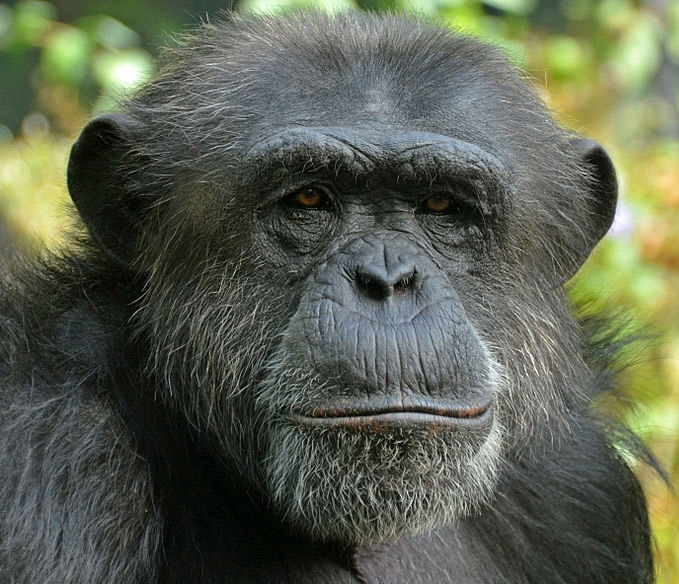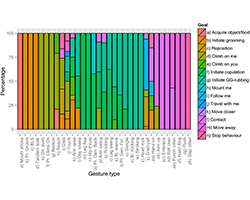
When Great Apes High-Five
show/hide words to know
Apparently Satisfactory Outcome (ASO): in a communication, the reaction of the recipient that makes the signaler stop gesturing.
Hominins: the group of animals that contains all modern and extinct humans.
Homoidae: the group of animals that contains all great apes, including Pan genus, hominins, and others like gorillas.
Pan genus: the group of animals that contains bonobos and common chimpanzees....more
Recipient: the one that receives a message in a communication.
Signaler: the one that sends out a message in a communication.
What's in the Story?
You’re at a party with two friends.
“Let’s play table football!” one of your friends suggests, “We just need one more player.”
At that moment, another kid asks, “Can I join your side?”
The competition is fierce, but after ten minutes, you and the kid beat your friends! The kid says, “What a fun game—but it’s getting late, I have to go.”
You want to give him a high-five to celebrate before he leaves, so—slow motion starts here—you raise your hand and extend your fingers. You see him raising his hand as well, so you start to move your arm towards him. But you do not get the slap on the palm you expected. Instead, he waves and says goodbye. You are left standing with your hand in the air.
You may have experienced an awkward moment like this. Someone misunderstands your gesture—a body movement that expresses an idea or meaning. Researchers discuss great ape gesturing in the PLOS Biology article “Bonobo and Chimpanzee Gestures Overlap Extensively in Meaning.” Scientists found that 90% of gestures of bonobos overlap with those of chimpanzees. But do these gestures share the same meaning in each species?
We Are Not "Snow White"

Outside of what happens in fairy tales, it can be very difficult to understand other species.
In the Disney movies, Snow White talks to different creatures in the woods, and they seem to understand her. When we look outside of fairy tales, at communication between different species, we know that languages and gestures can be very difficult to understand between species.
Many great apes are able to engage in intentional communication. They “mean” something with their gestures. They are also able to direct their gestures toward a specific individual (usually another ape of the same species).
Both the “signaler” and the “recipient” can understand the gestures. However, to outsiders, gestures from another species can be really difficult to understand. If we take the example of a human watching a chimpanzee, we can hardly understand what the apes are communicating without years of studying the language.
But humans, chimpanzees, bonobos, and a few other species are all a part of the same group of great apes. Depending on when during evolution we developed these gestures, shouldn’t some species use some similar gestures to mean the same thing?
Past researchers tried to understand the meanings in great apes in an indirect way by looking at the situations in which gestures occur. But the researchers running this study built on this approach by looking at how other animals respond to a gesture.
Make Sure You Get a Response

For this study, scientists gathered new information on the communication of bonobos, like the one shown here. They then compared this data to that of chimpanzees, to see where gesture languages overlapped. Image by Evanmaclean.
When a great ape communicates with a gesture, if the recipient’s reaction is satisfactory, the ape will stop gesturing. That ape achieved its goal of sending the message. The recipient’s reaction, known as the “Apparently Satisfactory Outcome” (ASO), can help define the meaning of the “signaler” for each specific gesture.
Scientists present the first study of the meaning of the range of gestures of wild bonobos. They also compared the gestures of bonobos and chimpanzees. Although bonobos and chimpanzees are both great apes, chimpanzees in the past have been more well-studied than bonobos. However, bonobo communication may be closer to that of early humans, when our language started to evolve.
Researchers worked in the field at Wamba, Luo Scientific Reserve, Democratic Republic of the Congo. They analyzed 2,321 bonobo gesture instances (that’s a lot!) and found 33 gesture types and 14 unique ASOs. Some gestures have only 1 ASO. For example, “directed push” always corresponds to the ASO of “climb on me” in bonobos. Some gestures have more than one ASO. For example, in bonobos, “arm up” results in 2 ASOs, “contact” and “climb on me.” Bonobos do have distinct sets of meanings, just like chimpanzees.
Do Similar Gestures Mean the Same Thing?
Scientists know that bonobo and chimpanzee gestures overlap by 88% - 96%. But do these similar gestures share the same meanings? They tested this question with a statistical method called “randomization.” They randomly assigned the gestures to ASOs for each species 10,000 times. Then they checked whether they could obtain a similar overlap of gestural meaning between the two apes. The answer is “no”—such overlap cannot happen by chance.
Scientists validated that there is a large overlap in the meanings of gestures used by both bonobos and chimpanzees. But you may ask, why does this happen? Why are they different species but communicating with similar gestures and meanings?
There are two possible reasons suggested by the scientists. Biological inheritance (the same reason you look like your parents) could be one possible explanation. However, scientists are aware that there may be another way these similar gestures arise. Both animals live in similar environments and have similar bodies. These limit their gestural choices, making it likely that at least some gestures will overlap.
Tracing Communication Back Through Time
But we are still not so sure how this pattern of gestures and meanings evolves. Let’s take a closer look at the possibilities. Both bonobos and chimpanzees belong to the genus (the grouping of animals just above species) Pan. We humans are from the genus Homo—we are not from the Pan genus. But in fact, we are all great apes (Family Hominidae). This means at some point in the past, we shared an ancestor with bonobos and chimpanzees.
There are two ways these shared sets of gestures and meaning may emerge. First, the gestures may have already been present in the last common ancestor that humans shared with the Pan genus. Second, the gestures may have appeared after the Pan genus evolved, which may make these gestures unique to the Pan genus.
The key question to solve this puzzle is: does the hominin lineage (including us modern humans and extinct humans) also share and understand these great apes gestures?
There is no clear answer yet – but perhaps you can try for yourself. There is a “dictionary” of the apes’ gestures in the researchers’ article. Perhaps you can study up and try to communicate with chimpanzees at your nearest zoo or wildlife park.
Additional images via Wikimedia Commons. Chimpanzee face by Clément Bardot.
View Citation
Bibliographic details:
- Article: When Great Apes High-Five
- Author(s): Tin Hang (Henry) Hung
- Publisher: Arizona State University School of Life Sciences Ask A Biologist
- Site name: ASU - Ask A Biologist
- Date published: May 22, 2018
- Date accessed: January 11, 2025
- Link: https://askabiologist.asu.edu/plosable/when-great-apes-high-five
APA Style
Tin Hang (Henry) Hung. (2018, May 22). When Great Apes High-Five. ASU - Ask A Biologist. Retrieved January 11, 2025 from https://askabiologist.asu.edu/plosable/when-great-apes-high-five
Chicago Manual of Style
Tin Hang (Henry) Hung. "When Great Apes High-Five". ASU - Ask A Biologist. 22 May, 2018. https://askabiologist.asu.edu/plosable/when-great-apes-high-five
Tin Hang (Henry) Hung. "When Great Apes High-Five". ASU - Ask A Biologist. 22 May 2018. ASU - Ask A Biologist, Web. 11 Jan 2025. https://askabiologist.asu.edu/plosable/when-great-apes-high-five
MLA 2017 Style

Be Part of
Ask A Biologist
By volunteering, or simply sending us feedback on the site. Scientists, teachers, writers, illustrators, and translators are all important to the program. If you are interested in helping with the website we have a Volunteers page to get the process started.










